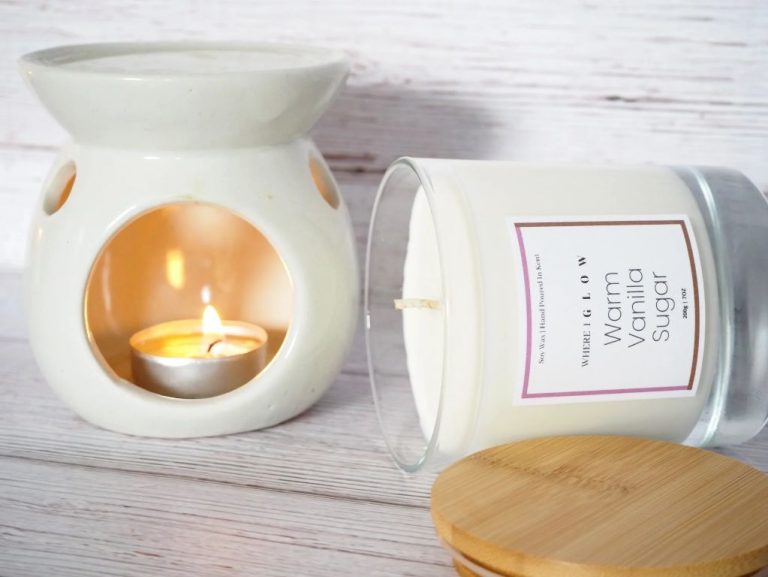Are Wax Melts Better For Your Health Than Candles?
Burning candles, made of materials such as paraffin wax and stearic acid, may increase indoor air pollution and come with alarming health risks. But in recent years, wax melts have emerged as an alternative that some market as safer and more eco-friendly. So are wax melts actually better for your health than candles?
This article investigates if switching from candles to wax melts offers health benefits or not. We’ll examine if wax melts produce less soot, limit exposure to dangerous chemicals, and improve indoor air quality compared to candles. Read on to uncover the truth behind these popular fragrance products and determine which is the healthier choice for you and your home.
Smoke and Soot
One of the main differences between candles and wax melts is that burning a candle produces smoke and soot, whereas wax melts do not. When a candle burns, it releases particulates into the air from the wick and wax. These can include smoke, soot, VOCs, and other potentially harmful substances. Wax melts, on the other hand, are simply heated in a warmer so there is no actual flame or smoke. The wax simply melts and releases fragrance into the air without any byproducts. This makes wax melts a cleaner and potentially healthier option compared to traditional candles.
Candle smoke contains fine particulate matter that can irritate lungs and worsen conditions like asthma. One study found scented candle use was associated with increased cough, wheezing, and shortness of breath. Soot can also dirty walls, furniture, and surfaces in a home. With wax melts, you avoid these issues entirely. For those sensitive to smoke or concerned about indoor air quality, wax melts are the better choice over candles.
Particulate Matter
Candles release particulate matter into the air when burned. Particulate matter refers to tiny particles that are emitted as solid or liquid droplets suspended in air. These particles come in different sizes, but of most health concern are fine particles with a diameter of 2.5 micrometers or less (PM2.5). When inhaled, they can travel deep into the lungs and cause irritation.
A study by Sundblad found that burning candles produced high levels of PM2.5, with paraffin wax candles generating the most particulate emissions (Sundblad, 2018). Another study measured indoor PM2.5 concentrations when burning scented candles, finding they increased to levels associated with cardiovascular and respiratory impacts (Loft et al., 2022). Exposure to particulate matter from candles has been linked to lung inflammation, airway constriction, and decreased lung function.

While more research is still needed, current evidence suggests frequent use of candles, especially paraffin-based, may raise health risks by increasing particulate pollution indoors.
Lead
Some candle wicks can contain lead, which releases lead particles into the air when burned. The EPA found that burning candles with lead-core wicks can generate dangerous levels of lead contamination in the air (CPSC Bans Candles With Lead-Cored Wicks). Lead exposure is especially hazardous for children and can cause developmental delays and brain damage. In 2003, the U.S. Consumer Product Safety Commission banned lead-core wicks in all candles (Beware of lead candle wicks that are poisoning your air). While regulations have reduced the use of lead in wicks, it’s still possible for candles, especially inexpensive imported ones, to contain lead. When burned, a lead-core wick can release five times the amount of lead considered hazardous for children. So it’s important to check candle wicks and purchase high-quality, lead-free candles.
Fragrance
Both wax melts and candles release fragrance compounds into the air as they burn. These synthetic fragrances contain various chemicals that can be harmful to human health. According to a 2016 study published in the National Center for Biotechnology Information (https://www.ncbi.nlm.nih.gov/pmc/articles/PMC5093181/), fragranced consumer products have been associated with migraines, asthma attacks, and respiratory difficulties. Another 2023 study (https://www.ncbi.nlm.nih.gov/pmc/articles/PMC10051690/) found that fragrance chemicals can negatively impact human health through skin, respiratory, and systemic effects.
Allergies and Asthma
Candles and wax melts can both trigger allergies and asthma attacks for some individuals. When a candle or wax melt is burned, they release volatile organic compounds into the air. These chemical compounds can act as respiratory irritants and exacerbate asthma and allergy symptoms. The chemical fragrances added to many candles and wax melts are common triggers. Sources of irritation also include the soot and particulates released when a candle or wax melt is burned.
During the holidays, scented candles are very popular but can lead to asthma attacks for many people. Candles don’t burn hot enough to destroy the dangerous molecules released into the air. It’s recommended that people with asthma or allergies avoid scented candles and wax melts, or opt for unscented versions instead.
Toxins
Both wax melts and candles produce toxins when heated, which can negatively impact indoor air quality and health. However, there are differences in the types of toxins released.
Candles often contain paraffin wax, which produces toxins like acetone, benzene, toluene, and formaldehyde when burned (Source). These substances are associated with irritation of the eyes, skin, and respiratory tract. The soot released can also contain polycyclic aromatic hydrocarbons (PAHs), which are carcinogenic. Lead wicks previously used in some candles released lead into the air as well.
Wax melts typically use vegetable-based waxes like soy, palm, or coconut. When heated, these release lower levels of toxins compared to paraffin candles. However, there is still some emission of volatile organic compounds (VOCs) like formaldehyde (Source). The heating method for wax melts also avoids issues like soot from a wick.
For both candles and wax melts, the fragrance oils added are a major source of VOCs and allergens released into the air. Unscented or naturally-scented products are optimal to limit toxins.
Safety
One of the biggest differences between candles and wax melts is in terms of safety. Candles pose a significant fire hazard, whereas wax melts do not require an open flame and are therefore much safer. According to the National Fire Protection Association (NFPA), candles caused 4% of reported home fires, 3% of home fire deaths, 6% of home fire injuries, and 4% of the direct property damage in home structure fires during 2009-2013 source. The U.S. Fire Administration (USFA) reports that annually, an estimated 23,600 fires in residences are caused by candles, resulting in 1,525 civilian injuries, 165 fatalities, and $390 million in direct property damage per year source. On average, 20 home candle fires are reported each day according to the USFA source. Wax melts completely remove the open flame hazard, making them a much safer option in homes with children and pets.
Environment
When it comes to their environmental impact, wax melts generate less waste than candles. This is because wax melts utilize only a small amount of wax at a time, whereas candles require a larger wax mass to burn. According to https://www.lalueurcandles.com/blogs/blog/are-candles-bad-for-the-environment, burning a candle produces more soot and releases more chemicals into the air compared to melting a wax melt. The soot and chemicals can be harmful to the environment, especially aquatic life. Wax melts produce less soot and release fewer chemicals. Their small size also means that very little wax ends up in landfills compared to used candles. When disposed properly, wax melts generate minimal waste and have less of an impact on the environment than frequently burning candles.
Conclusion
In conclusion, both candles and wax melts have potential downsides when it comes to health and safety. However, there are some key differences between the two that may make wax melts a better choice for many people.
Wax melts produce less smoke and soot than candles, reducing issues with indoor air pollution. They also eliminate concerns over lead in candle wicks. When it comes to fragrance, both candles and melts can trigger asthma, allergies and headaches in sensitive individuals. But melts may pose slightly less risk as you have more control over fragrance strength.
In terms of safety, open flames from candles can directly cause burns and fires. While wax melts come with a small risk of burns from the melting wax and warmer, overall they offer a reduced safety hazard.
Environmentally, both candles and wax melts generate some waste from their packaging. However, wax melts likely have a smaller footprint as the melts and warmers are reusable, while candles are single-use.
Overall, for most people, wax melts are likely a healthier and safer option than burning candles. But those sensitive to fragrances may want to avoid both or limit exposure. Consider your specific health conditions and needs when deciding between candles versus melts in your home.





